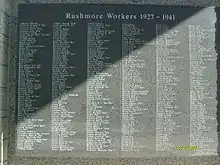Workers' Memorial Day
Workers' Memorial Day, also known as International Workers' Memorial Day or International Commemoration Day for Dead and Injured, takes place annually around the world on April 28, an international day of remembrance and action for workers killed, disabled, injured, or made unwell by their work.[1] In Canada, it is commemorated as the National Day of Mourning.
| Workers' Memorial Day | |
|---|---|
| Also called | International Commemoration Day (ICD) for Dead and Injured |
| Type | Non-religious, cultural |
| Observances | Labour |
| Date | April 28 |
Workers' Memorial Day is an opportunity to highlight the preventable nature of most workplace incidents and ill health and to promote campaigns and union organization in the fight for improvements in workplace safety. The slogan for the day is Remember the dead – Fight for the living.[1]
Although April 28 is used as the focal point for remembrance and a day of international solidarity, campaigning and other related activities continue throughout the year right around the world.
Origins

In 1989, the AFL-CIO declared April 28 "Workers' Memorial Day" to honor the hundreds of thousands of working people killed and injured on the job every year. April 28 is the anniversary of the date the Occupational Safety and Health Act of 1970 went into effect, and when the Occupational Safety and Health Administration was formed (April 28, 1971). Previously, in 1984, the Canadian Union of Public Employees (CUPE) established a day of mourning. The Canadian Labour Congress declared an annual day of remembrance in 1985 on April 28, which is the anniversary of a comprehensive Workers' Compensation Act (refer to the entry Workplace Safety & Insurance Board), passed in 1914. In 1991, the Canadian parliament passed an Act respecting a National Day of Mourning for persons killed or injured in the workplace, making April 28 an official Workers’ Mourning Day.[1][2]
International recognition
For years Workers' Memorial Day events have been organized in North America, and then worldwide. Since 1989, trade unions in North America, Asia, Europe and Africa have organized events on April 28. The late Hazards Campaigner Tommy Harte brought Workers' Memorial Day to the UK in 1992 as a day to ‘Remember the Dead: Fight for the Living’. In the UK the campaign for Workers’ Memorial Day has been championed by the Hazards Campaign and taken up by trade unions, adopted by Scotland's TUC in 1993, followed by the TUC in 1999 and the Health and Safety Commission and Health and Safety Executive in 2000.[1][2]


April 28 is recognised by the International Labour Organization (ILO) and the International Trade Union Confederation (ITUC) as International Workers' Memorial Day. In 1996 the ICFTU commemorated Workers' Memorial Day and began to set annual 'themes'. For 2006 the ICFTU theme was Union workplaces: safer workplaces, focusing on a global ban on asbestos and increased awareness of HIV/AIDS.[3] During 2001 the ILO, part of the United Nations, recognised Workers' Memorial Day and declared it World Day for Safety and Health at Work and in 2002 the ILO announced that April 28 should be an official day in the United Nations system.[1][2]
Workers' Memorial Day is recognised as a national day in many countries including: Australia, Argentina, Belgium, Bermuda, Brazil, Canada, Dominican Republic, Gibraltar, Ireland, Luxembourg, Panama, Peru, Portugal, Spain, Thailand, Taiwan, United States and the United Kingdom. Trade unions in other countries including Benin, Czech Republic, Finland, Hungary, Malta, Nepal, New Zealand, Romania and Singapore are pursuing government recognition.[1][2]
Workers’ Memorial Day is now an international day of remembrance of workers killed in incidents at work, or by diseases caused by work, and annually on April 28, Workers' Memorial Day events are held throughout the world. Some examples include active campaigning, and workplace awareness events. Public events include speeches, multi-faith religious services, laying wreaths, planting trees, unveiling monuments, balloon releases, raising public awareness of issues and laying out empty shoes to symbolize those who have died at work.
World Day for Safety and Health at Work
| World Day for Safety and Health at Work | |
|---|---|
| Observed by | Workers Worldwide (Geneva for the year 2011) |
| Type | International |
| Significance | work environment, occupational safety and health |
| Date | April 28 (annually) |
| Related to | International Workers' Day, Labour Day, Labor Day |
World Day for Safety and Health at Work is a UN international day that is celebrated every April 28. It is concerned about safe work and awareness of the dimensions and consequences of work-related accidents and diseases; to place occupational safety and health (OSH) on the international and national agendas; and to provide support to the national efforts for the improvement of national OSH systems and programmes in line with relevant international labor standards.[4]
The 2011 World Day for Safety and Health at Work focuses on the implementation of an Occupational Safety and Health Management System (OSHMS) as a tool for continual improvement in the prevention of workplace incidents and accidents.[5]
Bangladesh
Bangladesh Garment Sramik Sanghati, an organization working for the welfare of garment workers, has requested that April 24 be declared Labour Safety Day in Bangladesh, in memory of the victims of the Rana Plaza building collapse.[6]
Labour safety statistics
United States labor safety statistics

.jpg.webp)
- In the United States, there are approximately 155 million workers.[7]
- In 2012, 4,628 workers died from work-related injuries, an average of 12 deaths per day.[8]
- An estimated 53,000 deaths caused by occupational illnesses occurred in 2007.[9] There is no comprehensive system that counts deaths from occupational illnesses.
- In 2012, employers reported nearly 3 million non-fatal injuries and illnesses to private industry workers and 793,000 to state and local government workers.[10]
- About 2.8 million work-related injuries were treated in emergency departments, resulting in 140,000 hospitalizations in 2012.[8]
- The economic burden of occupational injuries and illnesses was estimated at $250 billion in 2007. This estimate accounted for medical costs, productivity losses, and the societal costs of work-related fatalities, injuries, and illnesses.[8]
The National Institute for Occupational Safety and Health (NIOSH) conducts research and makes recommendations to prevent work-related injury, illness, and death. Additionally, NIOSH collaborates with other federal agencies, academic institutions, industry, and labor and professional organizations to move research into effective injury and illness prevention practices. As part of its national effort to protect workers from injury and illness, and in conjunction with Workers’ Memorial Day efforts globally, NIOSH contributes relevant data, case reports, and other findings from its surveillance and research activities to the Morbidity and Mortality Weekly Report (MMWR) prepared and published by the Centers for Disease Control and Prevention (CDC).
Worldwide labor safety statistics

According to the International Labour Organization (ILO), across the world:
- Each year, more than two million men and women die as a result of work-related accidents and diseases
- Workers suffer approximately 270 million accidents each year, and fall victim to some 160 million incidents of work-related illnesses
- Hazardous substances kill 440,000 workers annually – asbestos claims 100,000 lives
- One worker dies every 15 seconds worldwide. 6,000 workers die every day. More people die while at work than those fighting wars.[11]
See also
- National Safety Council
- UNRIC (United Nations Regional Information Centre)
- Work accident
References
- Greater Manchester Hazards Centre Fact Sheet April 28, 2006 (GMHC is part of the Hazards Campaign recognised and affiliated to the UK Trades Union Congress) Author Hilda Palmer, (no ISBN); available at http://www.gmhazards.org.uk/WMDLft06.pdf Also 'Safety Express' March/ April 2006 Page 5 'April 28 is...Workers' Memorial Day' (no ISBN); published by The Royal Society for the Prevention of Accidents (RoSPA) UK registered charity No. 207823
- TUC Certificate in Occupational Health & Safety course notes 2004/5 Section C page 69 (no ISBN).
- "Union Workplaces – Safer Workplaces" (PDF). April 28, 2006. Retrieved April 27, 2008.
- Programme on Safety and Health at Work and the Environment (SafeWork) – International Labour Organization.
- World Day for Safety and Health at Work – 28 April 2011 – International Labour Organization.
- "Thousands mourn collapse victims of Rana Plaza garment factory one year on". Deutsche Welle. April 24, 2014. Retrieved July 20, 2014.
- National Institute for Occupational Safety and Health
- Workers’ Memorial Day
- Leigh JP. Economic burden of occupational injury and illness in the United States. Millbank Q 2011; 89:728–72
- Bureau of Labor Statistics. Economic news release: workplace injury and illness summary. Washington, DC: US Department of Labor, Bureau of Labor Statistics; 2012.
- Trades Union Congress (UK) 'Hazards at Work: Organising for Safe and Healthy Workplaces' ISBN 1-85006-754-6. Also ILO fact sheet 'Facts on Safety at Work' published by the ILO April 2005 (no ISBN); available at http://www.ilo.org/public/english/bureau/inf/fact/index.htm
External links
| Wikimedia Commons has media related to Workers' Memorial Day. |
- Canadian Injured Workers Society
- Programme on Safety and Health at Work and the Environment (SafeWork), International Labour Organization
- NIOSH: Workers' Memorial Day
- NIOSH Science Blog: Workers' Memorial Day
- MMWR: Workers' Memorial Day 2014
- MMWR: Workers' Memorial Day 2013
- MMWR: Workers' Memorial Day 2012
- MMWR: Workers' Memorial Day 2011